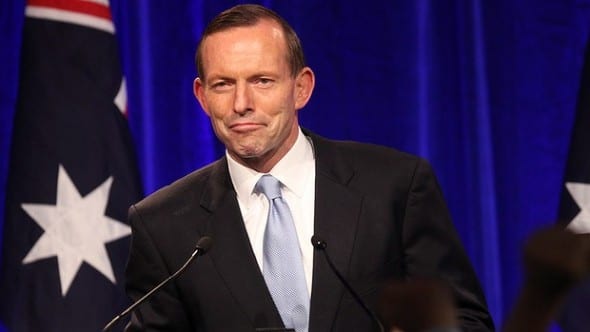Australian Prime Minister Tony Abbott has said he can imagine a future where the world no longer uses fossil fuels.
That might seem like a major step forward for a leader who dislikes wind turbines and has cut the renewable energy target, but his vision has one major caveat: He can only see it once every tonne of coal and every molecule of gas has been burned.
Abbott expressed this vision while launching the Agricultural Competitive White Paper in rural Victoria on the weekend, a document that all but ignored the potential impact of climate change on one of Australia’s biggest export industries.
“One day the coal will have been dug up, the gas will have been extracted, but we will always need food and our land forever,” Abbott told reporters in Victoria on Saturday.
Indeed, we will always need food. But it seems that the man who was elected, at least partially, because of his obsession with deficits in fiscal budgets, has not yet got his mind across deficits in carbon budgets. Or the implications of running a huge carbon budget deficit on agriculture.
Just a reminder of what that carbon budget is: The world needs to leave at least two-thirds of its current fossil fuel reserves in the ground if it wants to avoid what everyone agrees should be the global collective target, trying to cap emissions at a maximum of 2°C.
In Australia’s case, that means reducing emissions quickly. At current rates, it will exhaust its own share of the budget within 17 years, the Climate Change Authority says – a result it says would be “inequitable” for future generations and against the national interest.
Abbott, however, has stated that coal is good for humanity, and his government has repeatedly said it will seek to exploit as much of its coal and gas reserves as it can, even if demand for those resources is falling. His policies have already sparked a reversal in the decline of coal fired generation in Australia, as we report here today.
His government has based its energy white paper, and even the emissions reduction discussion paper, on scenarios that would result in global temperatures rising around 4°C. This would have a devastating impacts on Australia and its agriculture.
Not that Agriculture Minister Barnaby Joyce – who still questions the link between climate change and human activity – was perturbed by the probability of such an outcome, when challenged about it in an interview on Friday:
“I’ve noted that Joel Fitzgibbon (the Labor spokesman who criticised the government on this point) didn’t get up to page 109, where we started to talk about climate change.”
Page 109? That’s where the Coalition started to talk about climate change, and finished talking about it almost as quickly. There is no mention of climate change in the 12-page white paper at a glance document, no mention in the first 108 pages of the main document; but five whole paragraphs – a total of 334 words – on pages 109 and 110.
They are looking to store more water in dams, they want to invest in the forecasting abilities of the Bureau of Meteorology – even though Abbott’s main business advisor says they shouldn’t be trusted – invest in new irrigation techniques and drought tolerant plants.
“These are real and tangible things. We came up with tactile ways of dealing with the problem,” Joyce said.
But, what about not emitting in the first place? Joyce didn’t get asked. And he won’t be asked this question on Q&A on Monday evening either, because Abbott has told him he is not allowed to be there.
Here’s the whole five paras from the Agricultural Competitive White Paper:
Climate change presents particular challenges for sectors such as agriculture where productivity and profitability are closely linked to natural resources. Recent projections from the CSIRO and the Bureau of Meteorology (the Bureau) confirm that Australia’s climate has changed and will continue to change into the future. Average temperatures are expected to increase, with more heat extremes and fewer cold extremes. In southern Australia, severe droughts are expected to be more frequent and cool season rainfall is expected to decline. Overall, extreme rainfall events that lead to flooding are likely to become more intense. Farm management practices need to be adapted to build resilience in light of the challenges presented by such long-term trends.
The Commonwealth provides funding to institutions like the CSIRO and the Bureau, which provide valuable information to the farming community in the form of short-term and seasonal forecasts, and long-term climate projections that can be used to support risk assessment and adaptive farm management practices.
The Commonwealth continues to assist farmers to become more responsive and resilient to climate impacts, including through RD&E. For example, under the first round of the Rural Research and Development for Profit Programme the Government will support improvements in the Bureau’s seasonal forecasting model to increase farmer profitability (further detail in Chapter 3—Strengthening our approach to drought and risk management).
The Government is also working internationally to mitigate future climate risks. Australia is on-track to reduce greenhouse gas emissions by 5 per cent below 2000 levels by 2020 (13 per cent below 2005 levels) and the Emissions Reduction Fund (ERF) is helping Australia meet that target.
The Government will shortly announce Australia’s post-2020 emissions reduction target. The target will represent Australia’s fair share of the global effort to respond to climate change as part of the new post-2020 international climate change agreement under the United Nations Framework Convention on Climate Change. The Government is consulting the agriculture sector on our post-2020 target—submissions received have outlined policies to reduce emissions while improving productivity and profitability.











